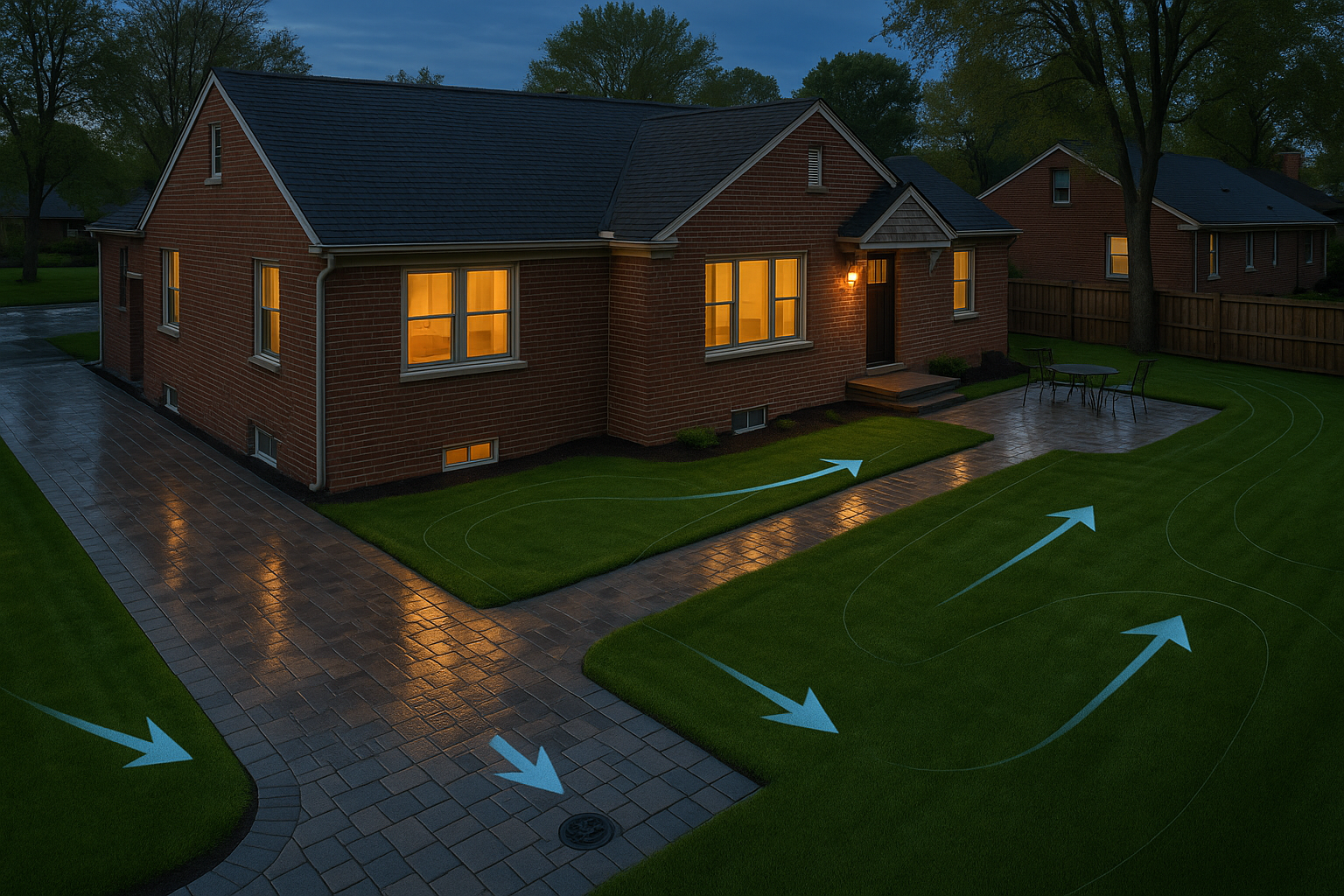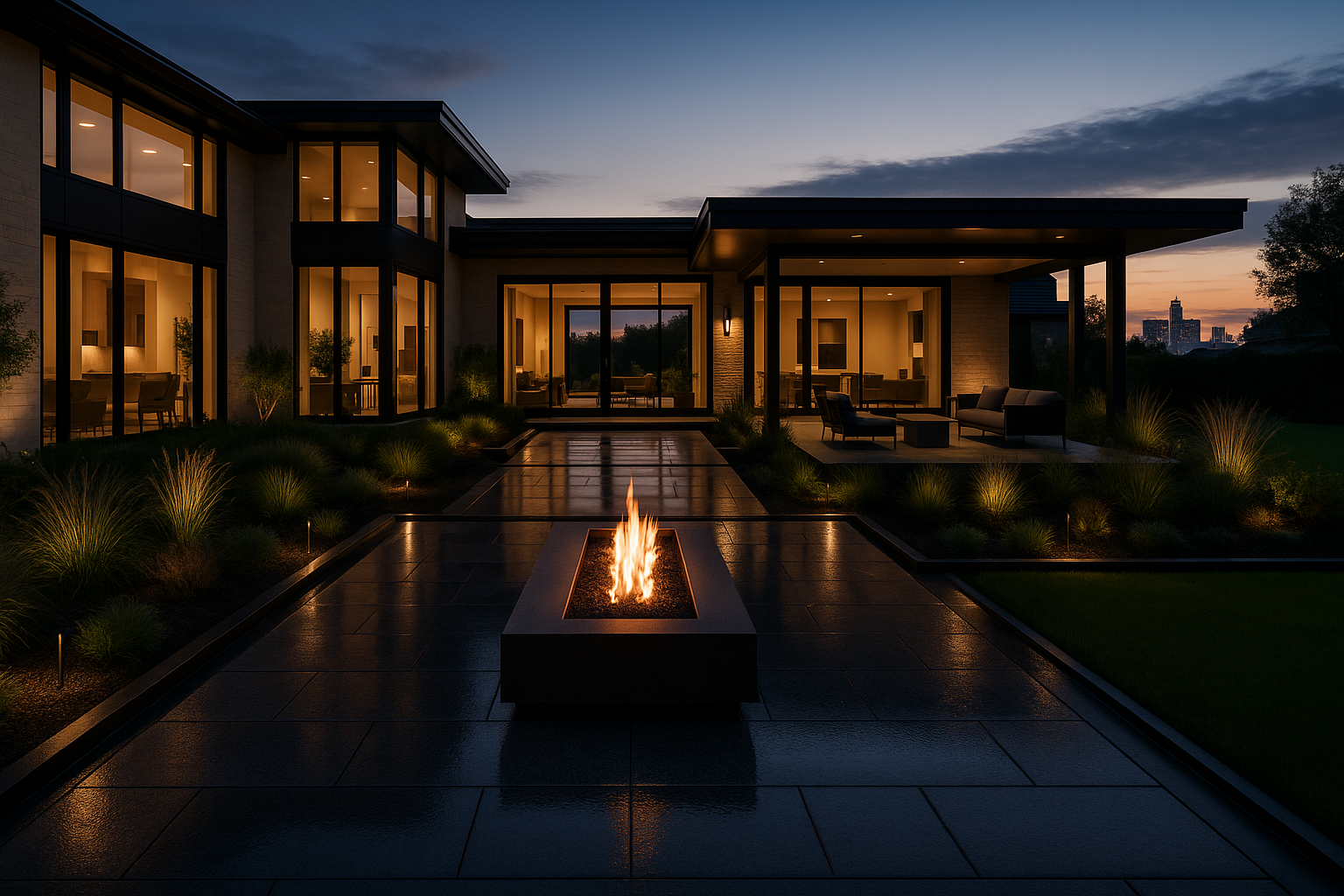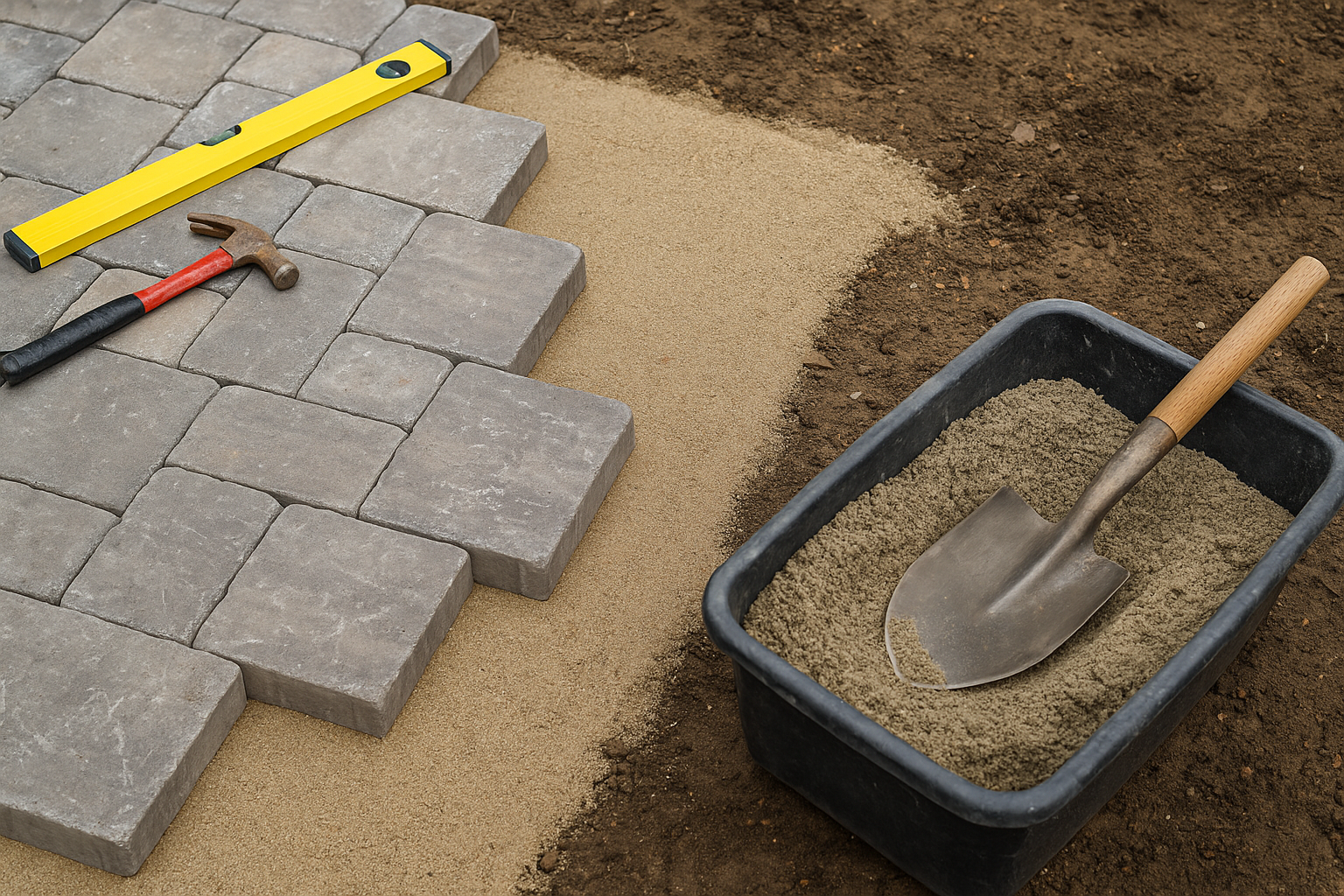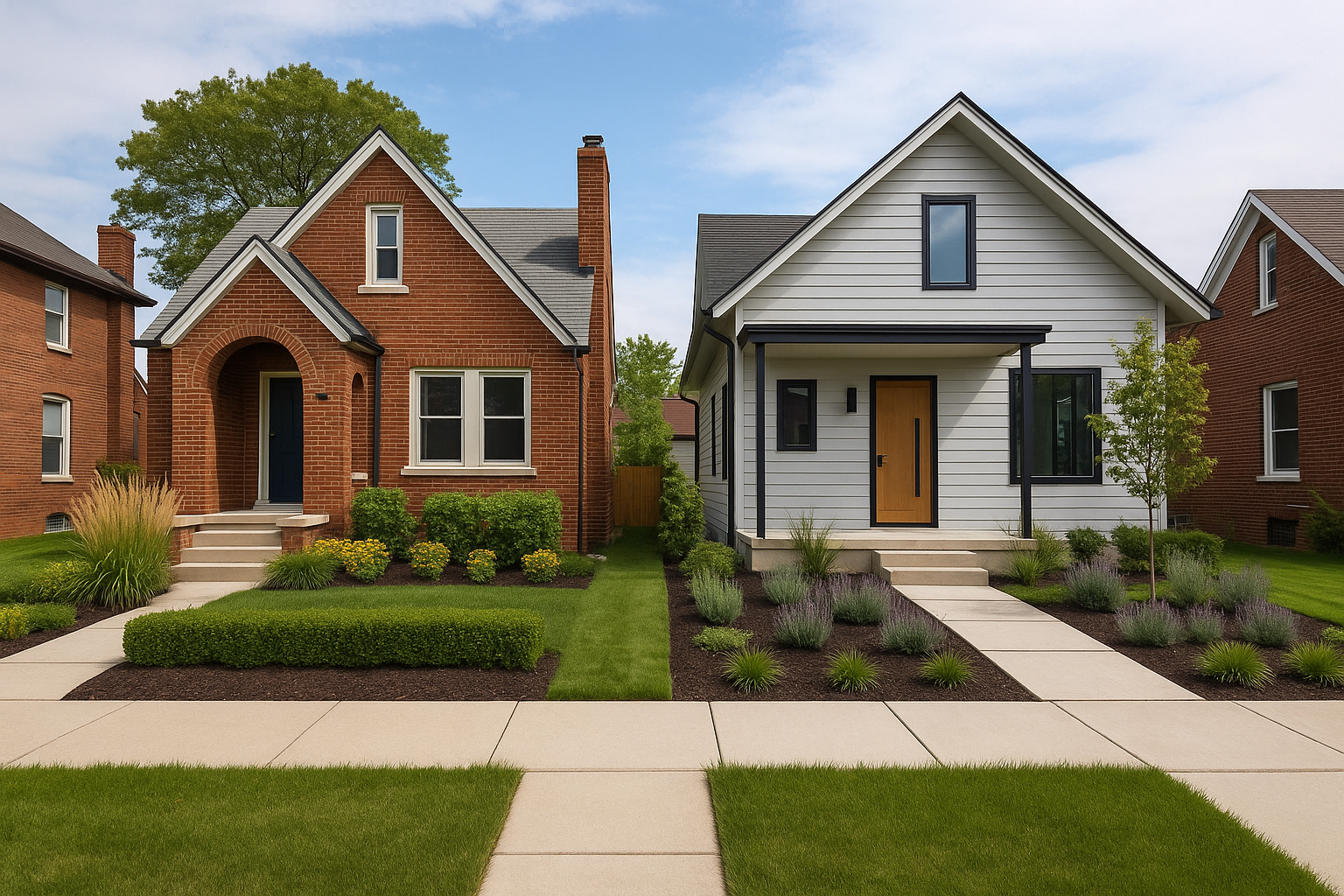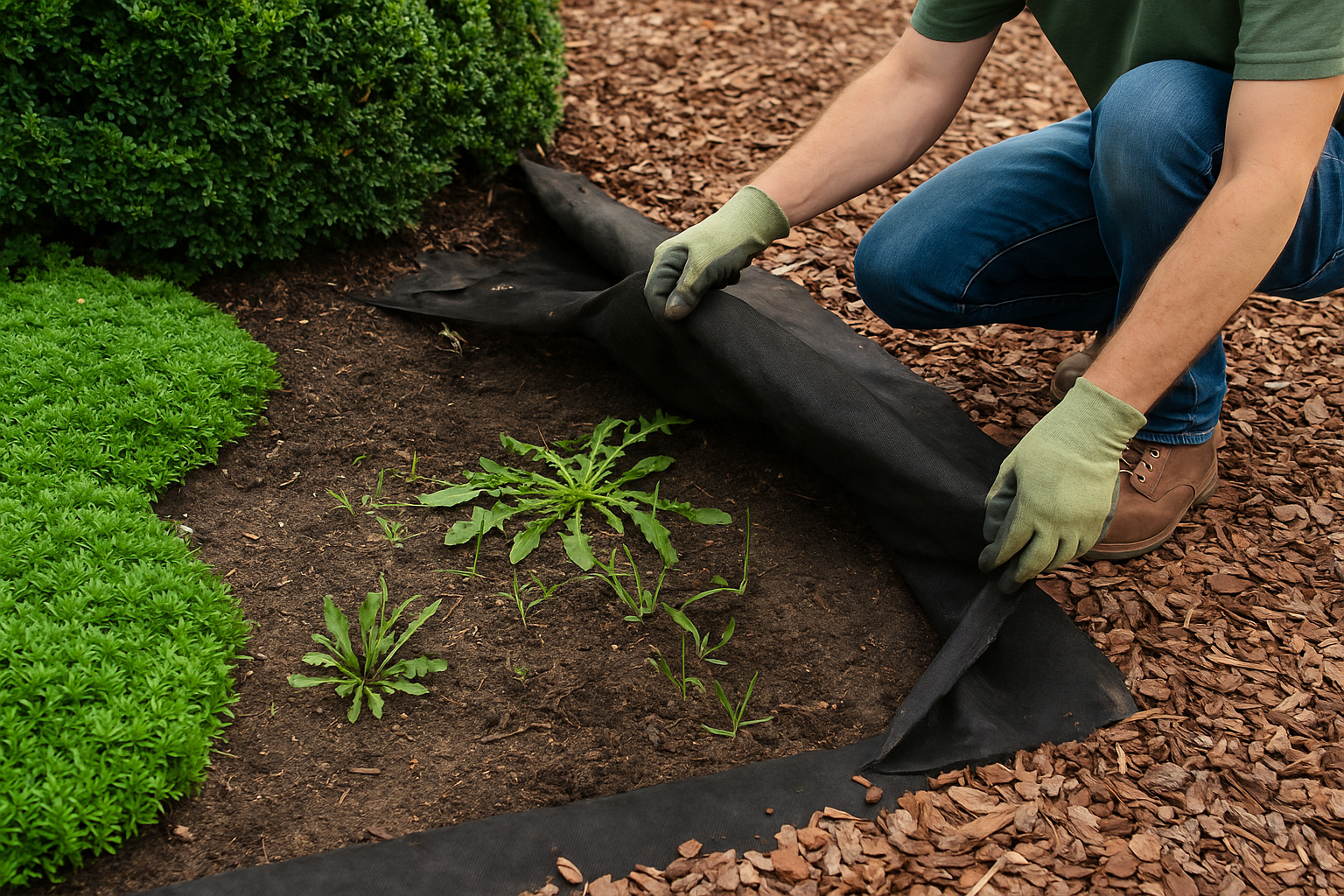Drainage Problems in Detroit Yards: How Landscaping Prevents Costly Water Damage

Understanding Detroit Yard Drainage Issues — The Hidden Danger Under Your Lawn
Most homeowners don’t think about drainage—until it becomes a problem. A small puddle after heavy rain may seem harmless at first. A soft spot in the yard feels like nothing more than an annoyance. But beneath the surface, these are early warning signs of far larger issues that can quietly erode both your property’s health and its long-term value.
In Detroit, the risks tied to drainage are even greater. Our unique combination of dense clay soils, harsh freeze-thaw cycles, and extreme seasonal precipitation makes water one of the most destructive elements your yard will face. And once drainage problems start, they often don’t fix themselves — they compound.
Before you know it, you’re looking at shifting patios, foundation cracks, dying plants, and costly repairs. That’s why understanding how Detroit’s environment contributes to poor drainage is the first step to protecting your landscape and home.
Why Drainage Is a Bigger Problem in Detroit
The Heavy Burden of Detroit’s Clay Soil
Not all dirt is created equal. Much of Southeast Michigan, including Detroit, sits on clay-heavy soil, which behaves very differently than lighter soils like loam or sand. Clay particles are incredibly small and tightly packed. Instead of absorbing rainwater, this soil tends to repel it, forcing water to sit on the surface far longer than it should.
When rain falls faster than the soil can absorb, it pools. In yards without proper grading or drainage systems, these pools turn into stubborn patches of standing water that linger long after the storm has passed.
Freeze-Thaw: Nature’s Seasonal Jackhammer
Detroit homeowners are all too familiar with Michigan winters. But many don't realize that freezing and thawing cycles are some of the most destructive forces acting on their landscapes.
Here’s what happens:
- Water seeps into tiny soil cracks during warmer days.
- Overnight freezes cause that water to expand.
- The expanding ice pushes soil, patios, and even driveways upward.
- When the ice melts, it leaves voids, and the surface sinks.
Repeat this process dozens of times each winter, and you begin to see noticeable shifts in patios, walkways, and lawn grading. This ongoing movement is a major reason why even newer hardscapes eventually develop drainage issues.
Detroit’s Double Dose of Water
Beyond the soil type and cold temperatures, Detroit experiences intense precipitation swings. Springtime snowmelt combines with heavy spring rains, often overwhelming lawns that are already saturated. Summer thunderstorms dump large amounts of water in a short time, adding to the problem.
Without an effective system in place, water collects in low-lying areas of the property, sometimes funneling directly toward the house itself.
How Backyard Flooding Starts — And Spreads
Flooding rarely happens overnight. It builds slowly, starting with subtle changes in how your yard holds water:
- Low lawn depressions turn into seasonal ponds.
- Water begins to flow toward the foundation rather than away from it.
- Plant beds stay soggy long after the rain is gone.
- Lawn equipment leaves ruts because the ground remains saturated.
The damage often isn’t fully visible until you start noticing physical consequences—like sinking patios or cracking walkways—which brings us to the next section: how to recognize when your yard is in trouble.
Signs Your Yard Has a Drainage Problem
Most drainage problems are silent at first, but they leave plenty of clues along the way. The sooner you spot them, the easier and cheaper they are to fix.
Standing Water That Sticks Around
If water remains pooled in your lawn for more than 24-48 hours after a rainfall, your drainage system is failing. This is particularly common near patio edges, fence lines, or low backyard areas. Repeated pooling leads to lawn suffocation, weed growth, and eventually mud zones that are difficult to repair.
Persistent Mud Patches
You may not always see full-blown puddles, but chronically muddy areas are another sign that water isn’t draining properly. These spots often form in shaded areas or where slight grading issues go unnoticed.
Pro tip: Walk your property a day or two after heavy rain. Do you sink into parts of your lawn? That’s where drainage corrections are needed.
Hardscape Shifting or Settling
When patios, driveways, or walkways begin to tilt or buckle, drainage is often the underlying cause. Improper water flow erodes the compacted base underneath paver stones or concrete, causing the surface to shift or sink unevenly.
- Brick paver patios may separate or tilt.
- Concrete slabs may crack or settle.
- Retaining walls may bow outward over time.
Foundation or Basement Moisture
This is where drainage issues start costing real money. Water that collects near your home’s foundation applies hydrostatic pressure against basement walls. Over time, this pressure leads to cracks, leaks, or worse — full water intrusion.
Dying Plants and Lawn Areas
Plants and lawns suffocate when exposed to too much water for extended periods. Root rot, fungal diseases, yellowing grass, and stunted shrubs often point to drainage issues below the surface.
How Poor Drainage Damages Your Entire Property
Once drainage failures take root, the damage spreads beyond aesthetics. What starts as puddles quickly leads to much larger financial consequences if left unresolved.
Lawn Failure & Turf Destruction
Saturated grass is starved of oxygen, which causes root systems to weaken and die. Diseased or thin grass creates open invitations for weeds and invasive pests to take over, degrading the appearance and health of your landscape.
Erosion Undermines Hardscapes
Water runoff eats away at the soil supporting your patios, retaining walls, or landscape installation projects. Without solid support, these surfaces collapse or crack, requiring major reconstruction far sooner than expected.
Garden & Tree Decline
Many trees, shrubs, and flowers planted in Detroit are not suited for standing water. Saturated soil leads to weakened root structures, nutrient leaching, and an open door for fungal pathogens to take hold.
Foundation Damage & Expensive Repairs
Perhaps the most costly consequence, prolonged water exposure near your home’s foundation can eventually result in basement flooding, cracks, and full foundation settlement. Repairs often cost thousands—and sometimes tens of thousands—if not addressed early.
Long-Term Financial Impact
What seems like a minor issue today becomes a major budget buster down the road. Water problems degrade nearly every part of your outdoor investment—turning beautiful backyard transformations into constant repair cycles.
Grading — The Foundation of Good Drainage
The first and most fundamental element of any drainage solution is grading. Even the most advanced drainage systems will fail if the land itself isn’t shaped to direct water properly. Grading isn’t about dramatic hills or trenches. In most cases, it involves subtle, professionally calculated slopes that gently guide water away from structures, patios, and vulnerable low spots.
A professional landscape company evaluates the existing topography of the property to determine where water naturally flows and where it’s pooling. From there, the soil is carefully sculpted during the landscape installation process to create proper runoff paths. This often includes adjusting the slope away from the home’s foundation, redirecting surface water toward collection zones or lower elevations designed to handle water safely.
Small changes can make a dramatic difference. A slope of just 2% — roughly a quarter-inch drop per foot — is often enough to keep water moving in the right direction. When executed properly, grading creates an invisible yet highly effective first layer of protection, minimizing both surface pooling and subsurface saturation.
Patios, driveways, and lawn areas all benefit from precise grading. If these surfaces are improperly leveled or tilted inward toward structures, they will naturally collect water, compounding drainage problems. Correcting this early ensures long-term durability for every outdoor element that follows.
French Drains & Subsurface Solutions
While grading handles much of the surface water, some properties require subsurface drainage systems to address more severe or chronic issues. One of the most widely used solutions in Detroit is the French drain—a tried-and-true method for redirecting water beneath the surface before it has a chance to accumulate.
A French drain consists of a perforated pipe installed within a gravel-filled trench. As water saturates the soil, it naturally flows into the gravel bed, filters into the pipe, and is then redirected away from the problem area toward a safe discharge point. This is especially effective for properties that deal with high groundwater tables or constant saturation.
Not all situations call for subsurface solutions, however. A professional evaluation determines when landscape company services like French drains are warranted versus when surface drainage or simple grading will suffice. Depth, pipe diameter, and outlet placement are all carefully calculated to ensure that the system remains effective over time.
For homes in areas like landscape warren mi, where water issues often stem from both heavy rainfall and naturally compacted soils, subsurface drainage systems can be a critical layer of defense that works in tandem with grading.
Hardscape & Landscape Design That Prevents Drainage Failures
Drainage isn’t just about managing lawn water—it’s equally vital when designing patios, walkways, driveways, and other hardscape features. Poorly installed hardscapes are among the most common sources of drainage problems because they interrupt the natural flow of water and often create unintended pooling zones.
Professionally installed hardscape design elements account for water movement from the start. For example, permeable pavers allow rainwater to filter through small gaps and into the soil below, reducing surface runoff. When done correctly, brick paver patios and paver driveways not only enhance the aesthetics of the property but actively support the drainage system.
In some cases, additional elements like dry creek beds, swales, or retaining walls are incorporated into the design. These features serve dual purposes — visually enhancing the landscape while quietly channeling excess water away from problem zones. Hardscape installation performed by experienced professionals includes properly layered gravel bases, geotextile fabrics to prevent soil migration, and edge restraints that ensure long-term stability even under heavy rains.
Rather than fighting against water, well-designed hardscapes work with it — channeling, absorbing, and redirecting moisture before it ever becomes a threat.
Why DIY Fixes Often Fail — And End Up Costing More
It’s tempting for homeowners to try to resolve drainage problems on their own. After all, solutions like adding extra downspout extensions, digging shallow trenches, or applying quick-fix surface grading seem simple enough. Unfortunately, these surface-level solutions rarely address the underlying problem — and in many cases, they make things worse.
Common mistakes include:
- Incorrect slope calculations that unintentionally move water toward foundations
- Shallow trenches that fill with water but have no true outlet
- Inadequate pipe sizing in French drains that quickly clog or overflow
- Failing to account for seasonal freeze-thaw movement
Even gutters and splash blocks — while useful — don’t replace proper drainage planning. Water will always follow gravity. Without a comprehensive system directing where that water goes after it leaves the roof, pooling remains inevitable.
The expertise offered by professional landscaping in detroit mi companies stems from years of hands-on experience with Detroit’s unique conditions. Every property is different, and there’s no one-size-fits-all fix. Working with a team like greater detroit landscape co ensures drainage is handled with long-term stability in mind, protecting both softscape and hardscape investments for years to come.
Long-Term Drainage Maintenance & Monitoring
Even the most perfectly installed drainage system requires periodic maintenance to continue functioning as designed. Detroit’s climate remains unforgiving year after year, and small issues can arise from winter frost, heavy storms, or natural yard settling.
Seasonal drainage checkups are an important part of ongoing care:
- After winter thaw, verify that water continues flowing properly and that no new low spots have developed.
- Clean any surface drains or grates of debris before spring rains arrive.
- Inspect French drains for signs of clogging or compromised outflow areas.
- Reapply joint sand to brick paver surfaces if settling has occurred.
Professional landscapers provide ongoing inspections to ensure that both landscape installation elements and hardscape features continue functioning at peak performance. Without this monitoring, minor drainage concerns can quietly resurface, slowly compromising previous repairs.
Proactive homeowners who work with a trusted landscape company minimize the risk of recurring drainage failures. By addressing issues early, the detroit landscape remains protected, healthy, and stable year after year — regardless of what Michigan’s weather throws at it.
Protect Your Detroit Property with Expert Drainage Solutions
Drainage issues in Detroit aren't something to postpone until they turn into major repairs. With proper evaluation, professional design, and long-term planning, these problems can be solved before they escalate. If you’re noticing any warning signs — or simply want peace of mind — it's smart to have your property professionally assessed.
To schedule a consultation with an experienced Detroit landscaping company that understands the unique drainage challenges of our region, visitRohto Landscaping. Investing in the right solutions today can save thousands down the road and ensure your landscape remains healthy, safe, and visually stunning for years to come.

